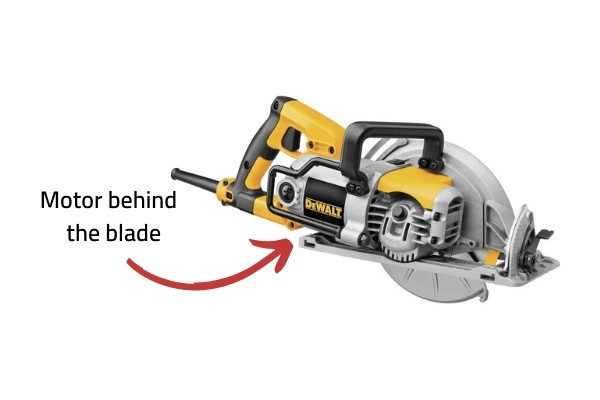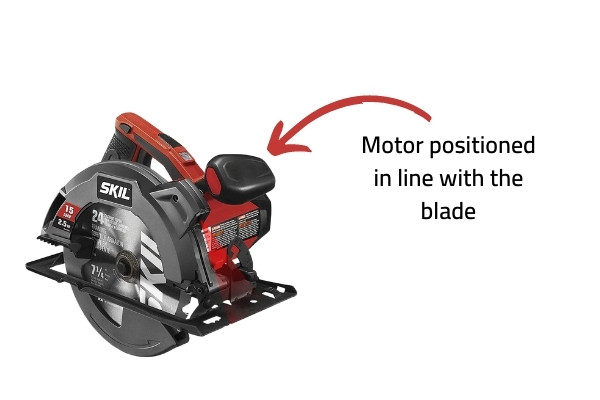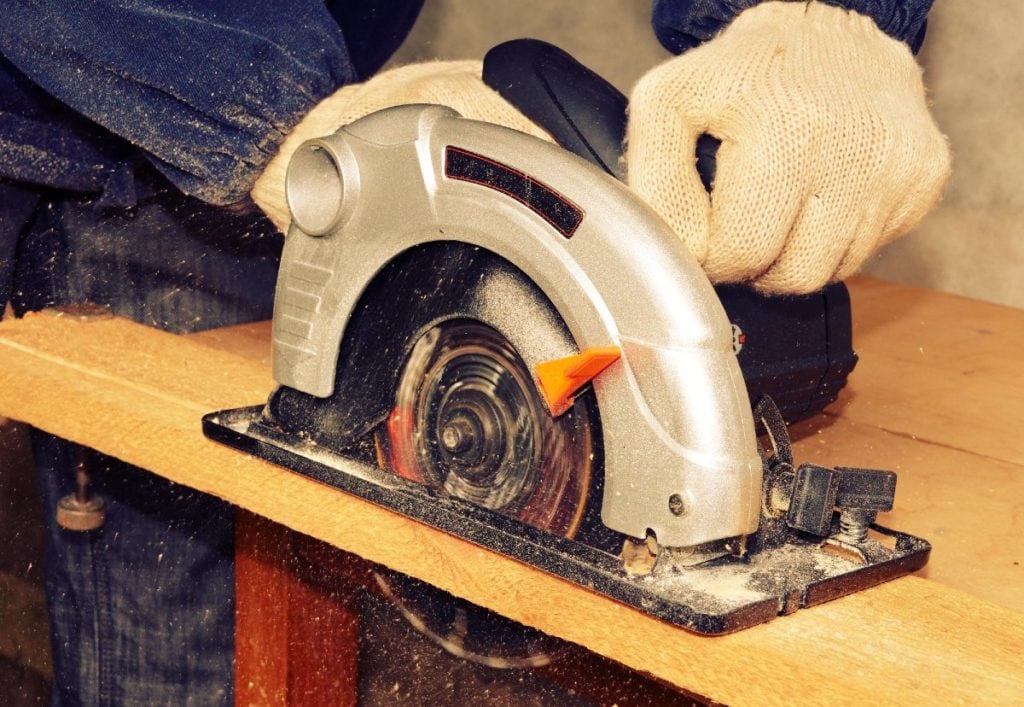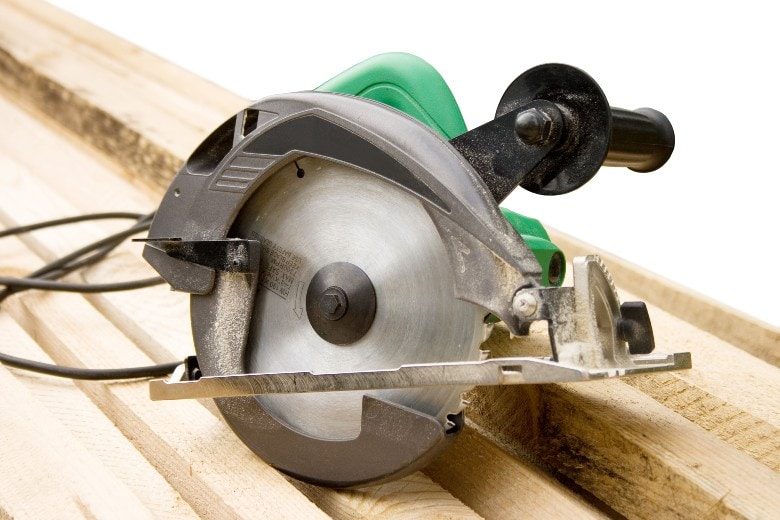As a woodworker, cutting and drilling will be the two ways you shape boards into projects that you can use or sell. In today’s woodshop, power tools reign supreme, and the circular saw is one of the most versatile cutting tools you can have.
Beginners and even those with some experience can feel overwhelmed by the selection of circular saws out there. The circular saw buying guide that follows will help you identify and choose the best circular saw for your needs.
Circular Saw Buying Guide
As a 27-year-old woodworker who began my woodworking journey 5 years ago, I can empathize with others trying to build their power tool collection. The circular saw is one of my go-to items in the shop, and I am writing this guide based on my experiences. Use the information that follows to help you in selecting the best circular saw for your woodworking hobby.
Where To Begin? Sidewinder vs. Worm Drive
Someone new to power tools may not understand what the terms sidewinder or worm drive mean. In short, these terms refer to the position of the electric motor to the saw blade.
Worm Drive circular saws
The worm drive design has been in use for nearly a century, thanks to manufacturers like Skilsaw. On worm drive circular saws, the electric motor sits behind the circular saw blade. It uses a spiral gear (“worm gear” where it gets the name) positioned at 90 degrees to rotate the saw blade.

ADVANTAGES
- Narrow body fits in smaller spaces
- Worm gear provides greater torque
- It has a better weight balance
DISADVANTAGES
- Extra gears increase the weight of the power tool
- Hand position makes it more difficult for beginners to control
Related: Best Worm-Drive Circular Saws (2024 Review)
Sidewinder circular saws
The design also referred to as the direct-drive circular saw was developed after the worm-drive circular saw. It has the electric motor mounted next to the saw blade instead of behind it. A spur gear turns the circular saw blade on these models.

ADVANTAGES
- Easier to control for new DIYers or hobbyists
- Weigh less thanks to fewer gears
- Will generate higher Rotations Per Minute (RPMs)
DISADVANTAGES
- Generates less torque than a worm drive
- The side motor shifts weight to one side of the power tool
Power Source: Corded vs Cordless
One of your most important decisions for a new circular saw will be what power source you wish to use. Today’s power tool market leans towards cordless designs in sizes that most DIYers and hobbyists will purchase. That does not mean that corded circular saws are not worth considering, though.
Corded circular saws
Corded designs preceded “portable” circular saws by a few years. These tools draw power through a standard 120-volt outlet. The corded circular saw can be more powerful than a cordless, but it uses fewer technology-driven features.
ADVANTAGES
- Unlimited power from the electrical grid
- More power allows for bigger electric motors to be used
- Corded circular saws are usually cheaper than similar cordless counterparts
DISADVANTAGES
- Its mobility is limited by the need for a power outlet
- Corded circular saws have fewer features
Cordless circular saws
Surprisingly, the first “portable” circular saw (the model “E” from Skilsaw) became available in 1928. Today’s products use the latest lithium-ion battery pack technology. Most manufacturers sell power tools based on battery platforms, allowing you to swap batteries between cordless tools.
ADVANTAGES
- A cordless circular saw is used anywhere you can carry it
- Cordless circular saws include the latest technology for power and safety
- You have a wider selection of features, power, and saw sizes in cordless designs
DISADVANTAGES
- These tools cost more than a corded saw of the same size
- Power is limited because you use battery packs instead of outlets
Related: Best Cordless Circular Saws of 2024
Power Ratings: What Do They Mean?
Manufacturers use several terms to describe the power of a circular saw. Those new to woodworking or power tools might not understand what these ratings mean. Ratings are consistent with corded designs, but they can fluctuate with cordless saws depending on battery pack status.
Amps rating
Corded circular saws have an amp rating. The term “amp” is a shortened version of the word “ampere,” a standard unit of electrical current.
An amp rating defines the current the electrical motor can carry without damaging or overheating the tool. The ability to absorb heat and dissipate it is what this rating shows. If you have two circular saws of the same rating, the one with a higher speed (RPMs) can potentially draw in more air and run cooler.
For optimum performance, look for a circular saw that pushes at least 15 amps. 13 and lower amp motors are ok for infrequent use and smaller jobs.
Amp Hours rating
Cordless battery packs have an amp hour rating. Here, the rating indicates the level of amps your battery pack will provide consistently for an hour. For example, a 2.6 amp hour rating informs you that the battery will provide 2.6 amps for an hour when fully charged (and in ideal conditions).
Remember that this rating also indicates the capacity of the battery platform, and a larger amp-hour rating should provide a longer charge under similar usage.
Volts
A volt is a standard unit used to indicate the potential of a charge in your battery pack on cordless circular saws. Most individual batteries in a pack deliver 3.6 volts, and stringing these together helps to increase a battery pack to the ratings (12, 18, 20, etc.) sold.
Your battery platform volt rating indicates the energy it provides. That energy determines the speed and torque of a compact circular saw.
20 V MAX battery packs
You may have seen the 20V MAX batteries and assumed that these provide more power than an 18-volt battery pack. I was surprised to find out that they do not.
A lithium-ion battery has a nominal rating of 3.6 volts and a maximum rating of 4.0 volts. Stringing five cells (batteries) together makes an 18v pack (rated nominally) or 20V MAX (max rating). Manufacturers are somewhat manipulative here, although most 20V MAX products include the company’s best features, which can make a difference.
The Size: Circular Saw Blade Diameter
Most woodworkers identify a circular saw by the size of the saw blade it uses. Hobbyists should consider one of these sizes:
- 6.5-inch: While there are smaller saws, this is the minimum you should go for in woodworking. Your cutting depth will be about 2.25 inches. Most of these products offer bare minimum accessories, including no blade tilt.
- 7.25-inch: It is the most common size, which means it often has the most features available. You have a cutting depth of 2.5 inches with most products this size. It will be heavier and cost more than the 6.5-inch models.
- 8.25-inch: A more robust option than the 7.25-inch for a bit more money. Cutting depths are similar, but this saw cuts a bit deeper at an angle. More weight and fewer blade options are things to consider here.
- 10.25-inch: These are powerful and designed for professional settings. Most products in this range have a cutting depth of 3.75 inches. These are expensive and weigh a lot.
Beyond Size: Blade Types
You need to select a blade size that matches your circular saw. From there, you need to pick the type of saw blade you want to use. A good way to break these down for beginners is as follows:
- Cross-cut blades – More teeth for making cuts across the wood grain
- Rip-cut blades – Fewer teeth and wide gullets for ripping with the grain
- Combination blades – A go-between that makes decent cross or rip cuts
- Specialty blades – A catch-all category for blades that cut fine edges or cut through paneling
Contact And Support: Shoe Material
Most shoes, or base plates, on a circular saw made from:
- Cast metals
- Aluminum
- Magnesium
Cast metals, including cast steel, are the cheapest materials used for shoes. They can be repaired easily compared to other materials but are more susceptible to damage. It also weighs more.
Aluminum is the most common base plate material. It is lighter and machines to a more flat surface. It is more expensive.
Magnesium is the latest material addition and provides the strongest shoe for a circular saw. It costs more than aluminum but is very smooth.
How Does It Feel: Ergonomics

Comfort is something to consider with your circular saw. It provides relief on a day’s worth of work and helps with your control.
Handles covered in rubber materials provide comfort and vibration absorption. Adding a slip-resistant texture increases your hold.
Balance is necessary, especially with sidewinder designs that are heavier on the motor side. Battery pack placement should not imbalance the saw.
Finally, ergonomic controls are easy to read, adjust, and secure. That helps maintain workflow and ease of use.
What else? Additional features
- Bevel capacity – Most designs provide the ability to tilt the saw blade at an angle to cut beveled edges.
- Changing saw blades – A variety of designs allow you to remove and install blades quickly, reducing downtime in your workshop.
- Ease of adjustment – Look for adjustments with creative knob, lever, and angle/distance scale combinations to make the saw easy for you to use.
- Electric brakes – A feature that stops a spinning blade right after the power is cut, providing a faster work pace and safety while you cut.
- Guide Rails – These accessories allow you to quickly butt up against the edge of your workpiece, providing a stable cut and allowing repeatability.
- Laser guides – Circular saws can drift, so features like a laser guide help you guide the saw to stay on the cutline across the board.
Frequently Asked Questions
Why buy a circular saw?
Cutting is one of two ways that you will shape wood into projects. I found the circular saw to be ideal as the first saw for my shop. It can perform cross cuts, rip cuts, or beveled cuts, and it reaches across large pieces of wood (like sheet goods or long timber).
It is portable, easy to store, and does not require lots of space to use.
What is the best circular saw to buy?
I have a detailed product review that covers several circular saws here. I found the DeWalt DWE575SB to be the best model on the market at this time.
Things that stand out on the 7.25-inch corded design include:
1. A blade brake that increases efficiency and safety
2. The extended bevel capacity of 57-degrees
3. A dust blower that works to keep the cut line clear
The only downsides to the product are possible issues that develop over long-term use, which has yet to be a problem in my woodshop.
Are circular saw blades universal?
No. As noted previously, saw blades can come in a variety of sizes. You can not use a bigger saw blade than your circular saw can load. Also, circular saw blades have various tooth patterns, sizes, and counts that perform better on particular woodcuts.
Some blades cut materials other than wood. Circular saw blades are available for metals or masonry.
The Final Cut
All wood shops need a straight-cutting power tool. The circular saw provides the reach and ease woodworkers need. Versatility, mobility, minimal space, and easy storage make the circular saw a power tool you can not afford to be without.
Ready to buy a circular saw? Check out these reviews:

